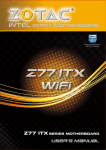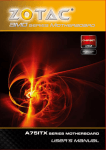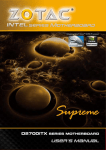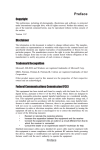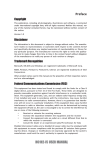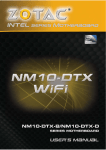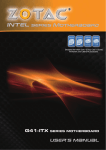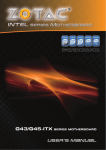Download Zotac E350-ITX Specifications
Transcript
WARNING! Electronic Emission Notices Federal Communications Commission (FCC) Statement This equipment has been tested and found to comply with the limits for a Class B digital device, pursuant to Part 15 of FCC Rules. These limits are designed to provide reasonable protection against harmful interference in a residential installation. This equipment generates, uses and can radiate radio frequency energy and, if not installed and used in accordance with instructions contained in this manual, may cause harmful interference to radio and television communications. However, there is no guarantee that interference will not occur in a particular installation. If this equipment does cause harmful interference to radio or television reception, which can be determined by turning the equipment off and on, the user is encouraged to try to correct the interference by one or more of the following measures: - - - - REORIENT OR RELOCATE THE RECEIVING ANTENNA INCREASE THE SEPARATION BETWEEN THE EQUIPMENT AND THE RECEIVER CONNECT THE EQUIPMENT INTO AN OUTLET ON A CIRCUIT DIFFERENT FROM THAT OF THE RECEIVER CONSULT THE DEALER OR AN EXPERIENCED AUDIO/TELEVISION TECHNICIAN NOTE: Connecting this device to peripheral devices that do not comply with Class B requirements, or using an unshielded peripheral data cable, could also result in harmful interference to radio or television reception. The user is cautioned that any changes or modifications not expressly approved by the party responsible for compliance could void the user’s authority to operate this equipment. To ensure that the use of this product does not contribute to interference, it is necessary to use shielded I/O cables. Copyright This manual is copyrighted with all rights reserved. No portion of this manual may be copied or reproduced by any means. While every precaution has been taken in the preparation of this manual, no responsibility for errors or omissions is assumed. Neither is any liability assumed for damages resulting from the use of the information contained herein. Trademarks All brand names, logos and registered trademarks mentioned are property of their respective owners. CAUTION: Risk of explosion if the battery is replaced with an incorrect type. Batteries should be recycled where possible. Disposal of used batteries must be in accordance with local environmental regulations. 1 AMD Fusion-ITX series Motherboard Table of Contents Motherboard Specifications----------------------------------------------------------------------------------4 Motherboard Layout--------------------------------------------------------------------------------------------6 Hardware Installation-------------------------------------------------------------------------------------------9 Safety Instructions-------------------------------------------------------------------------------------------9 Installing Memory Modules--------------------------------------------------------------------------------10 Installing the Motherboard---------------------------------------------------------------------------------11 Installing the I/O Shield--------------------------------------------------------------------------------11 Securing the Motherboard into the Chassis------------------------------------------------------11 Connecting Cables and Setting Switches--------------------------------------------------------------12 24-pin ATX Power Connector-PW1-----------------------------------------------------------------13 SPDIF-Out Header-CN4------------------------------------------------------------------------------14 COM Header-COM1 (Optional)---------------------------------------------------------------------14 Front panel header-FP1-------------------------------------------------------------------------------14 USB Headers-FP_U1/2/FP_USB3_1--------------------------------------------------------------15 Front Pannel Audio Header-FP_S1----------------------------------------------------------------15 Fan Connectors-----------------------------------------------------------------------------------------16 Serial-ATA (SATA) Connectors (SATA0/1/3/4)---------------------------------------------------16 Expansion Slots-----------------------------------------------------------------------------------------17 Jumper Settings-----------------------------------------------------------------------------------------17 Configuring the BIOS-------------------------------------------------------------------------------------------18 Enter BIOS Setup--------------------------------------------------------------------------------------------18 Main Menu-----------------------------------------------------------------------------------------------------18 Advanced Menu----------------------------------------------------------------------------------------------19 ACPI Settings--------------------------------------------------------------------------------------------19 CPU Configuration--------------------------------------------------------------------------------------19 IDE Configuration---------------------------------------------------------------------------------------20 USB Configuration--------------------------------------------------------------------------------------20 Super IO Configuration--------------------------------------------------------------------------------20 H/W Monitor----------------------------------------------------------------------------------------------20 X-Setting---------------------------------------------------------------------------------------------------20 Chipset Menu--------------------------------------------------------------------------------------------------21 GFX Configuration--------------------------------------------------------------------------------------21 OnBoard Device Config-------------------------------------------------------------------------------21 Boot Menu------------------------------------------------------------------------------------------------------22 Boot Settings Configuration--------------------------------------------------------------------------22 Security Menu-------------------------------------------------------------------------------------------------23 Administrator Password-------------------------------------------------------------------------------23 User Password-------------------------------------------------------------------------------------------23 Exit Menu-------------------------------------------------------------------------------------------------------24 2 Table of Contents Save Changes and Exit-------------------------------------------------------------------------------24 Discard Changes and Exit----------------------------------------------------------------------------24 Save Changes and Reset-----------------------------------------------------------------------------24 Discard Changes and Reset-------------------------------------------------------------------------24 Save Changes-------------------------------------------------------------------------------------------24 Discard Changes----------------------------------------------------------------------------------------25 Restore Defaults----------------------------------------------------------------------------------------25 Save as User Defaults---------------------------------------------------------------------------------25 Restore User Defaults---------------------------------------------------------------------------------25 Launch EFI Shell from filesystem device---------------------------------------------------------25 Flash Update Procedure -----------------------------------------------------------------------------------25 Installing Drivers and Software-----------------------------------------------------------------------------26 Drivers Installation -------------------------------------------------------------------------------------------26 Realtek HD Audio Driver Setup --------------------------------------------------------------------------34 Getting Started-------------------------------------------------------------------------------------------34 Sound Effect----------------------------------------------------------------------------------------------34 Mixer--------------------------------------------------------------------------------------------------------36 Audio I/O---------------------------------------------------------------------------------------------------38 Microphone------------------------------------------------------------------------------------------------42 3D Audio Demo------------------------------------------------------------------------------------------43 Information ------------------------------------------------------------------------------------------------43 3 AMD Fusion-ITX series Motherboard Motherboard Specifications qChipset v AMD® M1 q Size v Mini ITX form factor of 6.7 X 6.7 inch q Microprocessor support v AMD® E-350 (Dual-core, 1.6 GHz) q Operating systems v Supports Windows XP 32bit/64bit, Windows Vista 32bit/64bit and Windows 7 32bit/64bit q System Memory v Two 204-pin SO-DIMMs DDR3-1066 v Maximum memory size: 8 GB q USB 2.0 ports v Supports hot plug and play v Six USB 2.0 ports (four ports on the back panel, two via the USB brackets connected to the internal USB header) v Supports USB 2.0 protocol up to 480 Mbps transmission rate q USB 3.0 ports v Supports hot plug and play v Four USB 3.0 ports (two on the back panel, two via the USB bracket connected to the internal USB header) v Fully backward compatible with USB 2.0 and 1.1 specifications q Onboard Serial ATA ports v Independent DMA operation on four ports v Four SATAIII ports (6.0 Gb/s) q eSATA Port v One eSATA port on backpanel v Supports hot plug and play q Onboard LAN v Support Full Duplex flow control (IEEE802.3x) v 10/100/1000 BASE-T IEEE 802.3 compliant v Wake On LAN (WOL) power management support 4 Motherboard Specifications q WiFi support v Compliant with IEEE802.11n Draft 2.0 Standard v High speed wireless connection and enhanced wireless security v Max transfer rate up to 150 Mbps (optional for different models) q Audio v 8 channel High Definition Audio (including one optical SPDIF output port) v All DACs support 192k/96k/48k/44.1kHz sample rate v One SPDIF-out header on board q Green Function v Supports ACPI (Advanced Configuration and Power Interface) q Onboard Graphics Features v AMD® RADEON HD 6310 Graphics, DirectX11, 500 Mhz v Single-link DVI/HDMI/DP output (VGA compatible with adapter) v Support up to 2560x1600 resolution v Support AMD® UVD3.0 q Expansion slots v One PCI Express x4 slot (open-ended, PCI Express x16 devices supported*) v One Mini PCI Express slot (half-height) *Note: Users please note that when a PCIe x16 device is used on the x4 slot, its performance may be limited. 5 AMD Fusion-ITX series Motherboard Motherboard Layout Figure 1 shows the motherboard and Figure 2 shows the back panel connectors. 14 15 16 17 CPU_FAN APU DDRIII-2 1.5V DP/HDMI DDRIII-1 FP_USB3_1 1.5V K/B USB3.0 13 DVI 1 PW1 12 USB/e_SATA Chipset JP1 SATA1 SATA4 SYS_FAN SATA0 CN4 11 SATA3 LAN/USB Mini_PCIE FP1 FP_U1 COM1 FP_S1 SD1 PCIEX1 10 9 8 7 6 5 Figure 1 Figure 1. Board Layout 1. 2. 3. 4. 5. 6. 7. 8. 9. 6 24-pin ATX Power Connector-PW1 Clear CMOS Jumper-JP1 SYS Fan Connector-SYS_FAN Front Panel Header-FP1 Mini PCI Express Slot-Mini_PCIE Serial-ATA (SATA) Connectors (SATA0/1/3/4) PCI Express x4 Slot-PCIEX1 COM Header-COM1 (Optional) USB 2.0 Header-FP_U1 10. Front Pannel Audio Header-FP_S1 11. SPDIF-Out Header-CN4 12. Backpanel Connectors 13. USB 3.0 Header-FP_USB3_1 14. Chipset 15. APU 16. CPU Fan Connector-CPU_FAN 17. DDRIII Sockets-DDRIII-1~2 2 3 4 Rear panel Figure 2. Backpanel connectors 10 9 8 1 2 3 1. USB 3.0 Ports 11 7 4 5 6 2. HDMI Port 3. DVI Port 4. eSATA Port 5. USB 2.0 Ports 6. Optical SPDIF Output 7. Port Blue Green Pink Black Orange 2-Channel Line-In Line-Out Mic In -- -- 8. LAN port LED indicators Speed LED Activity LED 4-Channel Line-In Front Speaker Out Mic In -Rear Speaker Out 6-Channel Line-In Front Speaker Out Mic In Center/Subwoofer Rear Speaker Out Speed LED 8-Channel Side Speaker Out Front Speaker Out Mic In Center/Subwoofer Rear Speaker Out Activity LED Status Description Status Descritption Off Speed: 10 Mbps Off No link Green Speed: 100 Mbps Orange Linked Orange Speed: 1000 Mbps Blinking Data activity 9. DisplayPort 10. PS2 Keyboard/Mouse Port 7 AMD Fusion-ITX series Motherboard 11. WiFi antenna connectors (Optional) This motherboard can support two WiFi antenna modules. Refer to the following to install the WiFi antenna modules. Step 1. Remove the red caps from the WiFi antenna connectors. Step 2. Install the WiFi antennas to the WiFi antenna connectors, and make sure the screws are rotated in clockwise direction. 1.5V 1.5V Note: 1. Users please note that the appearance of your WiFi antenna modules may not be exactly the same as those shown in this manual. 2. Users can install one or two WiFi antennas to the motherboard. 3. Users can bend or rotate the WiFi antennas to the best receiving direction according to the picture below. 8 Hardware Installation Hardware Installation This section will guide you through the installation of the motherboard. The topics covered in this section are: q Installing Memory DIMMs q Installing the motherboard qConnecting cables and setting switches Safety Instructions To reduce the risk of fire, electric shock, and injury, always follow basic safety precautions. Remember to remove power from your computer by disconnecting the AC main source before removing or installing any equipment from/to the computer chassis. 9 AMD Fusion-ITX series Motherboard Installing Memory Modules 1.5V 1.5V Your new motherboard has two 1.5V 204-pin slots for SO-DIMM DDR3 memory. These slots support 1 GB/2 GB/4 GB DDR3 devices. There must be at least one memory bank populated to ensure normal operation. Refer to the following recommendations to install memory modules. DDRIII-1 DDRIII-2 Note that a memory module has a notch, so it can only fit in one direction. Refer to the following procedure to install memory modules into the slots on the motherboard. 1.Unlock a SO-DIMM slot by pressing the module clips outward. 2.Align the memory module to the SO-DIMM slot, and insert the module vertically into the slot. The plastic clips at both sides of the slot automatically lock the SO-DIMM into the connector. 10 Hardware Installation Installing the Motherboard The sequence of installing the motherboard into the chassis depends on the chassis you are using and if you are replacing an existing motherboard or working with an empty chassis. Determine if it would be easier to make all the connections prior to this step or to secure the motherboard and then make all the connections. It is normally easier to secure the motherboard first. Use the following procedure to install the I/O shield and secure the motherboard into the chassis. Note: Be sure that the CPU fan assembly has enough clearance for the chassis covers to lock into place and for the expansion cards. Also make sure the CPU Fan assem -bly is aligned with the vents on the covers. Installing the I/O Shield The motherboard kit comes with an I/O shield that is used to block radio frequency transmissions, protects internal components from dust and foreign objects, and promotes correct airflow within the chassis. Before installing the motherboard, install the I/O shield from the inside of the chassis. Press the I/O shield into place and make sure it fits securely. If the I/O shield does not fit into the chassis, you would need to obtain the proper size from the chassis supplier. Securing the Motherboard into the Chassis Most computer chassis have a base with mounting studs or spacers to allow the motherboard to be secured to the chassis and help to prevent short circuits. If there are studs that do not align with a mounting hole on the motherboard, it is recommended that you remove that stud to prevent the possibility of a short circuit. In most cases, it is recommended to secure the motherboard with spacers. 1.Carefully place the motherboard onto the studs/spacers located inside the chassis. 2.Align the mounting holes with the studs/spacers. 3.Align the connectors to the I/O shield. 4.Ensure that the fan assembly is aligned with the chassis vents according to the fan assembly instruction. 5.Secure the motherboard with screws. 11 AMD Fusion-ITX series Motherboard Connecting Cables and Setting Switches This section takes you through all the connectors and switch settings necessary on the motherboard. This will include: qPower Connectors v 24-pin ATX Power Connector-PW1 q Internal Headers/Connectors v SPDIF-Out Header-CN4 v COM Header-COM1 (Optional) v Front Panel Header-FP1 v USB Headers (FP_U1/2/FP_USB3-1) v Front Pannel Audio Header-FP_S1 q Serial-ATA (SATA) Connectors (SATA0/1/3/4) q Fan Connectors qExpansion Slots qCMOS Jumper Settings See Figure 1 to locate the connectors and jumpers referenced in the following procedure. 12 Hardware Installation 24-pin ATX Power Connector-PW1 1.5V 1.5V PW1 is the main power supply connector. Make sure that the power supply cable and pins are properly aligned with the connector on the motherboard. Firmly plug the power supply cable into the connector and make sure it is secure. PW1 12 24 1 13 PW1-Pin Definition Pin Signal Pin Signal 1 +3.3V 13 +3.3V 2 +3.3V 14 -12V 3 GND 15 GND 4 +5V 16 PS_ON 5 GND 17 GND 6 +5V 18 GND 7 GND 19 GND 8 PWROK 20 -5V 9 +5V_AUX 21 +5V 10 +12V 22 +5V 11 +12V 23 +5V 12 +3.3V 24 GND 13 AMD Fusion-ITX series Motherboard SPDIF-Out Header-CN4 This header provides a SPDIF (Sony/Philips Digital Interface) output to digital multimedia device through coaxial connector. CN4 - Pin Definition COM Header-COM1 (Optional) COM1 - Pin Definition Pin Signal 1 DCD 2 RXD 3 TXD 4 DTR 5 GND 6 DSR 7 RTS 8 CTS 9 RI 10 NC Front panel header-FP1 GND 2 SPDIF-out 3 VCC COM1 1 1.5V Signal Signal 1 1.5V Pin Pin The front panel header on this motherboard is one connector used to connect the following four cables : FP1-Pin Definition Pin Signal Pin Signal 1 HDD_LED+ 2 PW_LED+ 3 HDD_LED- 4 PW_LED- 5 GND 6 PWR_SW 7 RESET 8 GND 9 NC 10 KEY 1 CN4 FP1 q P WRLED Attach the front panel power LED cable to these two pins of the connector. The Power LED indicates the system’s status. q PWR SW Attach the power button cable from the case to these two pins. Pressing the power button on the front panel turns the system on and off rather than using the power supply button. q HDD LED Attach the hard disk drive indicator LED cable to these two pins. The HDD indicator LED indicates the activity status of the hard disks. q RST SW Attach the Reset switch cable from the front panel of the case to these two pins. The system restarts when the RESET switch is pressed. Note:Some chassis do not have all four cables. Be sure to match the name on the connectors to the corresponding pins. 14 Hardware Installation USB Headers-FP_U1/2/FP_USB3_1 This motherboard contains four USB 2.0 and two USB 3.0 ports that are exposed on the rear panel of the chassis. The motherboard also contains one 10-pin internal USB 2.0 header and one 20-pin USB 3.0 connector onboard. FP_USB3_1 Note: Secure the bracket to either the front or rear panel of your chassis (not all chassis are equipped with the front panel option). 1.5V 1.5V 1 FP_USB3_1-Pin Definition FP_S1 1 1 Pin FP_U1 FP_U1-Pin Definition Signal Pin Signal 1 NC 2 BD+ 3 AD+ 4 BD- 5 AD- 6 GND2 7 GND1 8 BSSTX+ PIN Assignment PIN Assignment 1 VCC 2 VCC 9 ASSTX+ 10 BSSTX- ASSTX- 12 GND3 3 USBP0- 4 USBP1- 11 5 USBP0+ 6 USBP1+ 13 GND 14 BSSRX+ ASSRX+ 16 BSSRX- 7 GND 8 GND 15 9 KEY 10 NC 17 ASSRX- 18 BVBUS 19 AVBUS 20 KEY Front Panel Audio Header-FP_S1 The audio connector supports HD audio standard and provides two kinds of audio output choices: the Front Audio, the Rear Audio. The front Audio supports Note: retasking function. In order to utilize the front audio FP_S1-Pin Definition header, your chassis must have front PIN Assignment PIN Assignment audio connector. Also please make sure the pin assignment on the cable 1 MIC2(L) 2 GND is the same as the pin assignment 3 MIC(R) 4 -ACZ-DET on the mainboard header. To find 5 Front Audio(R) 6 Reserved out if the chassis you are buying 7 FAVDIO-JD 8 Key(No pin) supports a front audio connector, 9 Front Audio(L) 10 Reserved please contact your dealer. 15 AMD Fusion-ITX series Motherboard Fan Connectors There are two fan connectors on the motherboard, including system fan connector-SYS_FAN and CPU fan connector-CPU_FAN. SATA0 SATA1 SATA3 SATA4 1.5V 1.5V CPU_FAN GND +12V Sense Control Control Sense +12V GND SYS_FAN Serial-ATA (SATA) Connectors (SATA0/1/3/4) The Serial ATA connector is used to connect the Serial ATA device to the motherboard. These connectors support the thin Serial ATA cables for primary storage devices. The motherboard incorporates four SATA III ports with maximum transfer rate up to 6.0 Gb/s each. SATA-Pin Definition 16 Pin Signal 1 GND 2 TXP 3 TXN 4 GND 5 RXN 6 RXP 7 GND Hardware Installation Expansion Slots 1.5V 1.5V The motherboard contains two expansion slots, one Mini PCIe slot and one PCIe x4 slot. Mini_PCIE PCIEX1 Mini PCI Express Slot-Mini_PCIE There is one Mini PCIe slot, reserved for the WiFi Module. PCI Express x4 Slot-PCIEX1 There is one PCI Express x4 slot that is designed to accommodate less bandwidth intensive cards, such as a VGA card. Jumper Settings This section explains how to configure the motherboard’s hardware. Before using your computer, make sure all jumpers and DRAM modules are set correctly. Refer to this section whenever in doubt. CMOS Clear Jumper-JP1 JP1 Selection 1 1-2* Normal* 1 2-3 CMOS Clear Close Open * = Default setting. If you want to clear the system configuration, use the JP1 (Clear CMOS Jumper) or SW1 (Clear CMOS Button) to clear data. Notice: 1. Be sure to save the CMOS setting when exit the CMOS. 2. If the CPU is frequency multiplier locked, no CPU speed change will be seen even if the frequency multiplier setting in CMOS setup is changed. 17 AMD Fusion-ITX series Motherboard Configuring the BIOS This section discusses how to change the system settings through the BIOS Setup menus. Detailed descriptions of the BIOS parameters are also provided. Enter BIOS Setup The BIOS is the communication bridge between hardware and software. Correctly setting the BIOS parameters is critical to maintain optimal system performance. Refer to the following procedure to verify/change BIOS settings. 1. Power on the computer. 2. Press the Del key when the following message briefly displays at the bottom of the screen during the Power On Self Test (POST). Pressing Del takes you to the BIOS Setup Utility. Note: 1. We reserve the right to update the BIOS version presented in the manual. The BIOS pictures shown in this section are for reference only. 2. It is strongly recommended that you do not change the default BIOS settings. Changing some settings could damage your system. Main Menu This menu gives you an overview of the general system specifications. The BIOS automatically detects the items in this menu. Note: q q q q 18 Users please note that the data in gray is non-changeable, and the others are for selection. BIOS Information Displays the auto-detected BIOS information. Memory Information Displays the auto-detected memory information. System Language Choose the system default language. System Date/Time Allows you to set the system date/time. Configuring the BIOS Advanced Menu The Advanced menu items allow you to change the setting for the CPU and other system devices. Press <enter> to display the configuration options: ACPI Settings The items in this menu allow you to set ACPI Configuration. q ACPI Sleep State Select the highest ACPI sleep state, the system will enter when the SUSPEND button is pressed. q USB Device Wakeup From S3 or S4 Use this item to enable or disable USB Device wakeup from S3 or S4. CPU Configuration The items in this menu show the CPU-related information that the BIOS automatically detects. Press <enter>to display the configuration options: q Limit CPUID Maximum Allows you to determine whether to limit CPUID maximum value. Set this item to [Disable] Windows XP operating system; set this item to [Enable] for legacy operating system such as Windows NT4.0.. q PSS Support Use this item to enable or disable PSS Support. q PSTATE Adjustment Use this item to adjust Performance State. q PPC Adjustment Use this item to adjust PPC. q NX Mode Use this item to enable or disable NX mode. q SVM Mode Use this item to enable or disable SVM mode. q C6 Mode Use this item to enable or disable C6 mode. 19 AMD Fusion-ITX series Motherboard IDE Configuration The items in this menu allow you to set or change the configurations for the IDE devices installed in the system. Press <enter>to display the configuration options: q OnChip SATA Channel Use this item to configure onchip SATA channel. q OnChip SATA Type Use this item to configure onchip SATA type. USB Configuration The items in this menu allow you to change the USB-related features. Press <enter> To display the configuration options: q Legacy USB Support Allows you to enable or disable support for USB devices on legacy operating systems. q USB3.0 Support Allows you to enable or disable USB3.0 support. q XHCI Hand-Off Allows you to enable support for operating systems without an XHCI hand-off feature. q EHCI Hand-Off Allows you to enable support for operating systems without an EHCI hand-off feature. q USB transfer time-out Allows you to set USB transfer time-out. q Device reset time-out Allows you to set device reset time-out. q Device power-up delay Allows you to set device power-up delay. Super IO Configuration The items in this menu allow you to configure IT8758 Super IO Chipset.. q Serial Port 0 Configuration Allows you to set parameters of Serial Port 0 (C0MA). H/W Monitor The items in this menu allow you to monitor the hardware status. Press <enter>to display the configuration options: q CPUFAN Mode Setting Use this item to select CPU FAN Control mode. X-Setting The X-Setting menu items show the settings of CPU, memory and so on. q Adjust Memory Voltage Use this item to adjust memory voltage. 20 Configuring the BIOS Chipset Menu The chipset menu items allow you to change the advanced chipset settings. Press <enter> to display the sub-menu: GFX Configuration The item allows you to configure north bridge features, including video, GPP, and so on. OnBoard Device Config The item allows you to configure south bridge features, including SB USB, SB GPP, and so on. 21 AMD Fusion-ITX series Motherboard Boot Menu The Boot menu items allow you to change the system boot options. Press <enter> to display the configuration options: Boot Settings Configuration The items allow you to configure Boot settings. Press <enter> To display the configuration options: q Setup Prompt Timeout Use this item to set number of seconds to wait for setup activation key. q Bootup NumLock State Use this item to select the keyboard NumLock state: [On] or [Off]. q Quiet Boot When set to [Disabled], displays normal POST message. When set to [Enabled], displays OEM Logo instead of POST messages. q GateA20 Active When set to [Upon Request], GA20 can be disabled using BIOS services. When set to [Always], GA20 can not be disabled; this option is useful when any RT code is executed above 1MB. q Option ROM Messages Use this item to set display mode for Option. q Interrupt 19 Capture When set to [Enabled], this function allows the option ROMS to trap interrupt 19. q Boot Option #1 This item displays the boot option. 22 Configuring the BIOS Security Menu The security menu items allow you to change the system security settings. Press <enter> to display the configuration options: Administrator Password Select this item to set Setup Administrator Password. User Password Select this item to set the user password. To set an Administrator/User Password: 1. Select the item [Administrator/User Password] and press <Enter>. 2. From the password box, type a password composed of at least six letters and/or numbers, then press <Enter>. 3. Confirm the password when prompted: The message “Password Installed” appears after you successfully set your password. To change the administrator/user password, follow the same steps as setting a use password. To clear the administrator/user password, select the item [Administrator/User password], then press <enter>. The message “Password Uninstalled” appears. 23 AMD Fusion-ITX series Motherboard Exit Menu The exit menu items allow you to load the option or failsafe default values for the BIOS items, and save or discard your changes to the BIOS items. Press <enter> to display the sub-menu: Save Changes and Exit Select this item and press <Enter> to save the changes that you have made in the BIOS Setup and exit the BIOS Setup. When the diolog box [Save configuration and exit?] appears, select [Yes] to save and exit, or select [No] to return to the main menu. Discard Changes and Exit Select this option only if you do not want to save the changes that you have made to the setup program. If you made changes to fields other than system date, system time, and password, the BIOS asks for a confirmation before exiting. Save Changes and Reset Select this item and press <Enter> to reset the system after saving the changes. When the diolog box [Save configuration and reset?] appears, select [Yes] to save and reset, or select [No] to return to the main menu. Discard Changes and Reset Select this item and press <Enter> to reset system setup without saving any changes. When the diolog box [Reset without saving?] appears, select [Yes] to discard and reset, or select [No] to return to the main menu. Save Changes Select this item and press <Enter> to save the changes that you have made in the BIOS Setup and exit the BIOS Setup. When the diolog box [Save configuration?] appears, select [Yes] to save changes, or select [No] to return to the main menu. 24 Configuring the BIOS Discard Changes This option allows you to discard the selections you have made and restore the previously saved values. When the dialog box [Load Previous Values?] appears, select [Yes] to discard any change and load the previously saved values. Restore Defaults Use this item to restore/load default values for all the setup options. Save as User Defaults Use this item to save the changes as User Defaults. Restore User Defaults Use this item to restore the User Defaults to all the setup options. Launch EFI Shell from filesystem device Use this item to launch EFI Shell application (Shellx64.efi) from one of the available filesystem devices. FLASH Update Procedure The program EFUDOS.exe is included in the driver CD (X:\Utility\EFUDOS.exe). Please follow the recommended procedure to update the flash BIOS, as listed below. (X: your CD driver letter). 1. Create a DOS-bootable floppy diskette. Copy the new BIOS file (just obtained or downloaded) and the utility program EFUDOS.exe to the diskette. 2. Allow the PC system to boot from the DOS diskette. 3. At the DOS prompt, type EFUDOS XX.ROM /P /B /N <ENTER> Note: XX (the BIOS file name) can be defined by users. 4. Wait until the flash-update is complete. 5. Restart the PC. Warning: - Do not turn off or RESET the computer during the flash process. - If you are not sure how to upgrade the BIOS, please take your computer to an Authorized Service Center and have a trained technician do the work for you. 25 AMD Fusion-ITX series Motherboard Installing Drivers and Software Note: It is important to remember that before installing the driver CD that is shipped in the kit, you need to load your operating system. The motherboard supports Windows XP 32 bit/64 bit, Windows Vista 32 bit/64 bit and Windows 7 32bit/64bit. The kit comes with a CD that contains utility drivers and additional software. The CD that has been shipped with your motherboard contains the following software and drivers: q AMD Chipset driver q Realtek HD Audio driver q Realtek PCIE network driver q VIA USB3.0 driver q MassStorage driver q Atheros Wireless Driver Note. We reserve the right to update the driver version presented in the manual. The driver installation pictures shown in this section are for reference only. Drivers Installation 1. Insert the driver CD into the drive after loading your operating system, and then you can see the interface below. 26 Installing Drivers And Software 2. Left-click AMD Chipset driver, begin loading 27 AMD Fusion-ITX series Motherboard 3. Left-click Realtek HD Audio driver, begin loading 28 Installing Drivers And Software 4. Left-click Realtek PCIE network Driver, and follow the instructions below to install the network driver. 29 AMD Fusion-ITX series Motherboard 5. Left-click USB 3.0 Controller Driver, begin loading 30 Installing Drivers And Software Note: USB 3.0 port would not work in POST, CMOS setup and DOS mode. 31 AMD Fusion-ITX series Motherboard 6. Left-click MassStorage driver, begin loading 7. Left-click Atheros Wireless driver, begin loading 32 Installing Drivers And Software At last, you can enter Computer Management that provides information about the hardware devices on this motherboard to check if the driver installation is complete. 33 AMD Fusion-ITX series Motherboard Realtek HD Audio Driver Setup Getting Started After Realtek HD Audio Driver being installed (insert the driver CD and follow the on-screen instructions), “Realtek HD Audio Manager” icon will show in System tray as below. Double click the icon and the control panel will appear: Sound Effect After clicking on the “Sound Effect” tab, 3 sections “Environment”, “Equalizer” and “Karaoke” are available for selection. Environment Simulation You will be able to enjoy different sound experience by pulling down the arrow, totally 23 kinds of sound effect will be shown for selection. Realtek HD Audio Sound Manager also provides five popular settings “Stone Corridor”, “Bathroom”, “Sewer pipe”, “Arena” and “Audio Corridor” for quick enjoyment. 34 Installing Drivers And Software Equalizer Selection The Equalizer section allows you to create your own preferred settings by utilizing this tool. In standard 10 bands of equalizer, ranging from 100Hz to 16KHz are available: Frequently Used Equalizer Setting Realtek recognizes the needs that you might have. By leveraging our long experience at audio field, Realtek HD Audio Sound Manager provides you certain optimized equalizer settings that are frequently used for your quick enjoyment. How to Use Other than the buttons “Pop” “Live” “Club” & “Rock” shown on the page, to pull down the arrow in “Others” , you will find more optimized settings available to you. Karaoke Mode Karaoke mode brings Karaoke fun back home by simply using the music you usually play, Karaoke mode can help you eliminate the vocal of the song or adjust the key to accommodate your range. Vocal Cancellation: Single click on “Voice Cancellation”, the vocals of the songs will be erased, while the background music is still playing which lets you take over the vocal part. Key Adjustment: Using “Up/Down Arrow” to find a key which better fits your vocal range. 35 AMD Fusion-ITX series Motherboard Mixer Realtek HD Audio Sound Manager integrates Microsoft’s “Volume Control” functions into the Mixer page. This gives you the advantage to you to create your favorite sound effect in one single tool. Playback control Mute You may choose to mute single or multiple volume controls or to completely mute sound output. Tool √ Show the following volume control This is to let you freely decide which volume control items to be displayed, total 13 items to be chosen. √ Advanced controls √ Enable playback multi-streaming 36 Installing Drivers And Software With this function, you will be able to have an audio chat with your friends via headphone (stream 1 from front panel) while still have music (stream 2 from back panel) playing. At any given period, you can have maximum 2 streams operating simultaneously. Recording control Mute You may choose to mute single or multiple volume controls or to completely mute sound input. Tool √ Show the following volume controls This is to let you freely decide which volume control items to be displayed. √ Advanced controls. Advanced control is a “Microphone Boost” icon. Once this item is checked, you will find “advanced” icon beside “Front Pink In” & “Mic Volume”. With this, the input signal into “Front Pink In” & “Mic Volume” will be strengthen. √ Enable recording multi-streaming At any given period, you can have maximum 2 streams operating simultaneously. 37 AMD Fusion-ITX series Motherboard Audio I/O Realtek HD Audio Manager frees you from default speaker settings. Different from before, for each jack, they are not limited to perform certain functions. Instead, now each jack is able to be chosen to perform either output (i.e. playback) function or input (i.e. Recording) function, we call this “Retasking”. Audio I/O aims to help you setting jacks as you wish. Moreover, other than blue to blue, pink to pink, the way that you used to do, Audio I/O would guide you to other right jacks that can also serve as microphone / speaker / headphone. 38 Installing Drivers And Software Speaker Configuration Step 1: Plug in the device in any available jack. Step 2: Dialogue “Connected device” will pop up for your selection. Please select the device you are trying to plug in. * If the device is being plugged into the correct jack, you will be able to find the icon beside the jack changed to the one that is same as your device. 39 AMD Fusion-ITX series Motherboard Connector Settings Click to access connector settings √ Mute rear panel when front headphone plugged in Once this option is checked, when front headphone is plugged, the music that is playing from the back panel, will be stopped. √ Disable front panel jack detection (option) Did not find any function on front panel jacks? Please check if front jacks on your system are so-called AC’97 jacks. If so, please check this item to disable front panel jack detection. √ Enable auto popup dialogue, when device has been plugged in. Once this item checked, the dialog “Connected device” would automatically pop up when device plugged in. S/PDIF Short for Sony/Philips Digital Interface, a standard audio file transfer format. S/PDIF allows the transfer of digital audio signals from one device to another without having to be converted first to an analog format. Maintaining the viability of a digital signal prevents the quality of the signal from degrading when it is converted to analog. 40 Installing Drivers And Software √ Output Sampling Rate - - - - 44.1KHz: This is recommended while playing CD 48KHz: This is recommended while playing DVD or Dolby 96KHz: This is recommended while playing DVD-Audio 192KHz: This is recommended while playing HD Audio √ Output Source - Output digital audio source: The digital audio format (such as .wav, .mp3,.midi etc) will come out through S/PDIF-Out. Speaker Calibration After you have successfully plugged in speakers and assigned to the right jacks, you are only one more step to go to enjoy the intended sound. We provide “Speaker Calibration” to help you check if the speakers are located in the correct position. 41 AMD Fusion-ITX series Motherboard Microphone This page is designed to provide you better microphone/recording quality. Below picture indicates both “Noise Suppression” & “Acoustic Echo Cancellation” are both enabled. Noise Suppression If you feel that the background noise, especially the sound generated from the fan inside PC, is too loud? Try “Noise Suppression”, which allows you to cut off and suppress disturbing noise. Beam Forming Also known as “directional recording”, this option lets you do the following: Once beam forming is enabled; only the sound from certain direction will be recorded. You will get the best quality if you chose 90° position, which we recommend you to use, this effectively means that you speak right into the microphone. Note: A Stereo Microphone is required when using Beam Forming function. Acoustic Echo Cancellation This function prevents playback sound from being recorded by microphone together with your sound. For example, you might have chance to use VOIP function through Internet with your friends. The voice of your friend will come out from speakers (playback). However, the voice of your friend might also be recorded into your microphone then go back to your friend through Internet. In that case, your friend will hear his/her own voice again. With AEC (Acoustic Echo Cancellation) enabled at your side, your friend can enjoy the benefit with less echo. 42 Installing Drivers And Software 3D Audio Demo The section “3D Audio Demo” grants you another possibility to enjoy your sound. The Audio Demo allows you to listen to sound in an extraordinary way. Information This section provides information about your current system audio device. 43 AMD Fusion-ITX series Motherboard 44 291-MA182-00














































